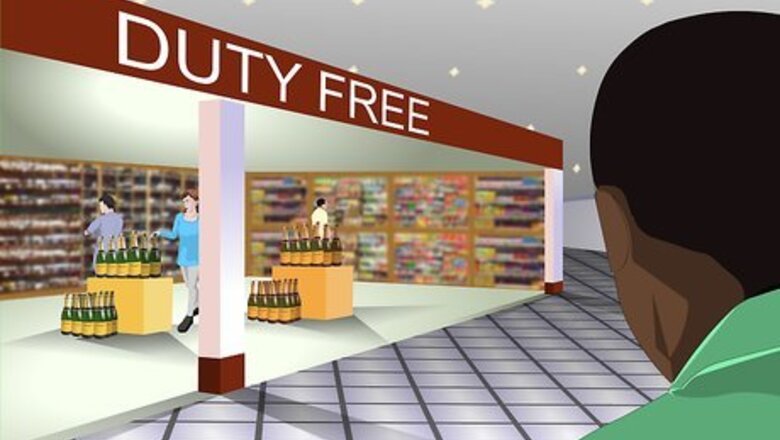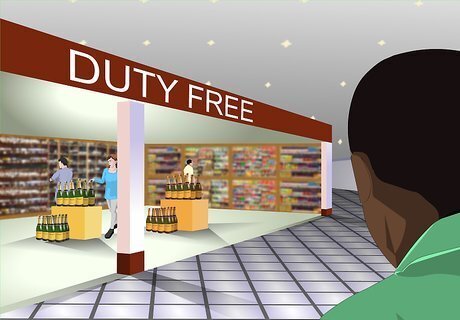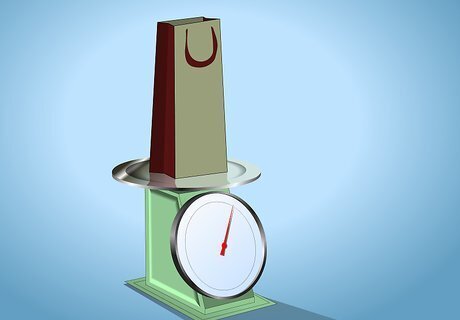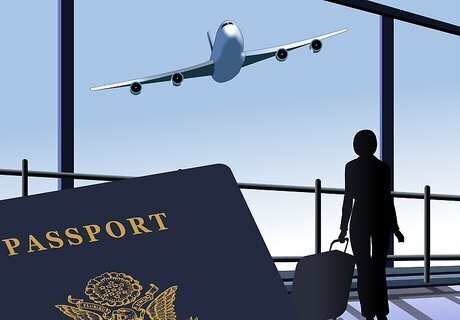
views
Buying Items Duty Free

Find a duty-free store. The first step to buying an item duty free is to locate a duty-free store. Duty-free stores can typically be found at any location that caters to or serves international travelers. Common locations for duty-free stores include international airports, towns and cities along an international border, cruise ships, ports, and on board certain international flights.

Determine if it's worth buying duty free. Some of the discounts you get at a duty-free store make it well worth your time and effort to make a purchase. However, other items may not be sold at a very good rate. For many items, you may be able to get a better deal by simply looking for those products on sale at a regular retailer. The duty-free rate also depends on the country whose products you are attempting to import. For example, in the U.S., certain items imported from Austria, Belgium, Denmark, Finland, France, Germany, Greece, Ireland, Italy, Luxembourg, the Netherlands, Portugal, Spain, Sweden, and the Ukraine are subject to a 100% rate of duty. Alcohol and tobacco are generally the best discounts you'll find at a duty-free store. Cameras and electronic products are usually not a very good deal. Retail items like cosmetics, clothing, and perfume can be hit or miss in terms of their value. If an item wouldn't normally be on sale at a regular retailer, you may get a deal, but otherwise it might be cheaper to look for these items on sale at a regular retail outlet. Candy and other confections are usually worth purchasing duty free if they are imported. However, regular candy that you can purchase at a supermarket is usually not a very good deal, and may actually be sold at an inflated price if you're buying at an airport duty-free store.

Bring your purchases with you. Duty/tax breaks are only applicable on products that will not be consumed or used while in that country. You generally have to take your purchases with you into the country you're visiting in order to ensure that you do not consume/use your purchases domestically. Many duty-free shops deliver your purchases to you as you physically leave the country. Your items may be delivered to you as you board a plane or as you drive or walk across an international border.
Mailing or Shipping Duty-Free Goods Through Customs

Determine a country's eligibility for unaccompanied purchases. Certain countries are eligible for unaccompanied purchases made by tourists. Unaccompanied tourist purchases simply means products that are bought by a tourist and then shipped through the postal service or a transportation service to the home of that tourist. Countries eligible for duty-free shipping back to the U.S. are categorized as either insular possession (IP) countries or Caribbean Basin Initiative (CBI) countries. IP countries are sovereign nations that are considered U.S. territories (excluding Puerto Rico). These include the U.S. Virgin Islands, American Samoa, and Guam.

Make purchases without exceeding your allowance. You are still subject to limitations on how much you can purchase when you ship items as an unaccompanied purchase. These items also count towards your overall allowance limits, so keep track of what you purchase and make sure you can account for those purchases when you fill out the necessary declaration paperwork. If returning to the U.S., you may bring up to five liters (169 fluid ounces) of alcohol as part of your allowable $1,600 exemption if at least four of those liters were purchased in the IP country and at least one of those liters was a product of that IP country. You may bring up to $800 in goods duty free if returning to the U.S. from an eligible CBI country. Only one bottle purchased in a cruise ship's duty-free store would be exempt from taxes. However, you may be allowed to bring back two bottles duty free if at least one of the bottles was the product of an eligible CBI country. Any additional bottles of liquor would be subject to a 1.5% flat duty rate, as well as additional Internal Revenue Service (IRS) taxes.

Ship your purchases from an eligible IP or CBI country. If you are visiting an eligible IP or CBI country, you will be able to ship certain products back to your home if you live in the U.S. In order to do so, you'll need to fill out a Declaration of Unaccompanied Articles form for each package you wish to send. You'll also need to complete a separate declarations form, CBP Form 6059B, which lists any items you purchased that you are bringing back with you. Some retailers offer these forms in store; if not, you can download and print them from the CBP website. Be aware that all mailed packages must be claimed within 30 days of arriving in the U.S. Anything unclaimed after 30 days will be returned to the sender. Ask the merchant to hold your item at the time of purchase. Let him/her know you will send a copy of the Declaration of Unaccompanied Articles form, also known as CPB (Customs and Border Protection) Form 255. Fill out a separate CBP Form 255 for each individual package/container you'll be sending back to the U.S., which will then have to be attached to the package before shipment. Pay any Customs duty and taxes you may owe upon returning to the U.S. A CBP officer will also verify your list and validate your form(s). Send the yellow copy of CBP Form 255 to the vendor who is holding your purchase. Keep the other copy you're given by CBP for your own records. Once your package clears Customs, the U.S. Postal Service will be delivered to your home (if you are shipping it through the USPS). If you're using a transportation service, you will be notified when your package arrives, and you'll be able to claim it at their office.
Determining Your Eligibility

Leave the country. You must leave the country in order to qualify for duty-free shopping, often for a minimum span of time. In the United States, for example, you must leave the country for at least 48 hours if you wish to take full advantage of U.S. duty-free stores. However, you may be able to purchase some quantities of duty-free goods if you're traveling for less than that time span. U.S. citizens may purchase a reduced quantity of duty-free goods if they've spent less than 48 hours in Canada, for example, and Canadian citizens may purchase a limited quantity of duty-free goods after any length of time in the United States. U.S. citizens traveling to Canada for under 48 hours may bring back up to $200 (U.S. Dollars) worth of goods per person without paying taxes or duties. However, alcohol and tobacco may be subject to duties and taxes if it was purchased on a brief trip. U.S. citizens who spend more than 48 hours in Canada may bring back up to $800 in goods per person, and will not have to pay taxes or duties on up to one liter (33.8 fluid ounces) of alcohol, one carton of 200 cigarettes, and 100 cigars.

Make purchases within your allowance. You may purchase up to the legal amount of goods in the duty-free store, though that amount will vary depending on where you are traveling and how long you will be gone. Product limitations are generally applied to high-tax items like alcohol and tobacco, though an overall limit is usually in place at most international borders. Most product-specific limitations restrict travelers to bringing back one liter (33.8 fluid ounces) of alcohol and one carton of cigarettes per person per trip. At the U.S./Canadian border, individuals may only bring up to $800 in goods per month. If you and one or more family members who reside at the same address travel together, you can collectively bring a total of $1,600 worth of goods per month per household.

Pay Customs duty on anything exceeding your allowance. You may exceed the allowance of goods you're able to bring back duty free. However, you will have to pay taxes/duties on those goods that exceed your allowance. How you pay will depend on where you live and what payment methods are at your disposal. You can pay in cash, but it must be in the currency of the nation whose Customs office you are dealing with. For example, if you're a U.S. citizen crossing from Canada back into the U.S., you'll need to pay the U.S. Customs office in U.S. currency. You can write a personal check for the exact amount of your Customs duty, provided you have a bank account within that country. For example, a U.S. citizen may make a personal check payment to the U.S. Customs office if he/she has a U.S.-based bank account. If making a payment by check, you will need to provide an authorized photo ID (typically either a passport or U.S. driver's license). You may also make a Customs payment by money order or traveler's check if the total you owe is below a certain amount. At the U.S. border, for example, that amount is set at $50.




















Comments
0 comment